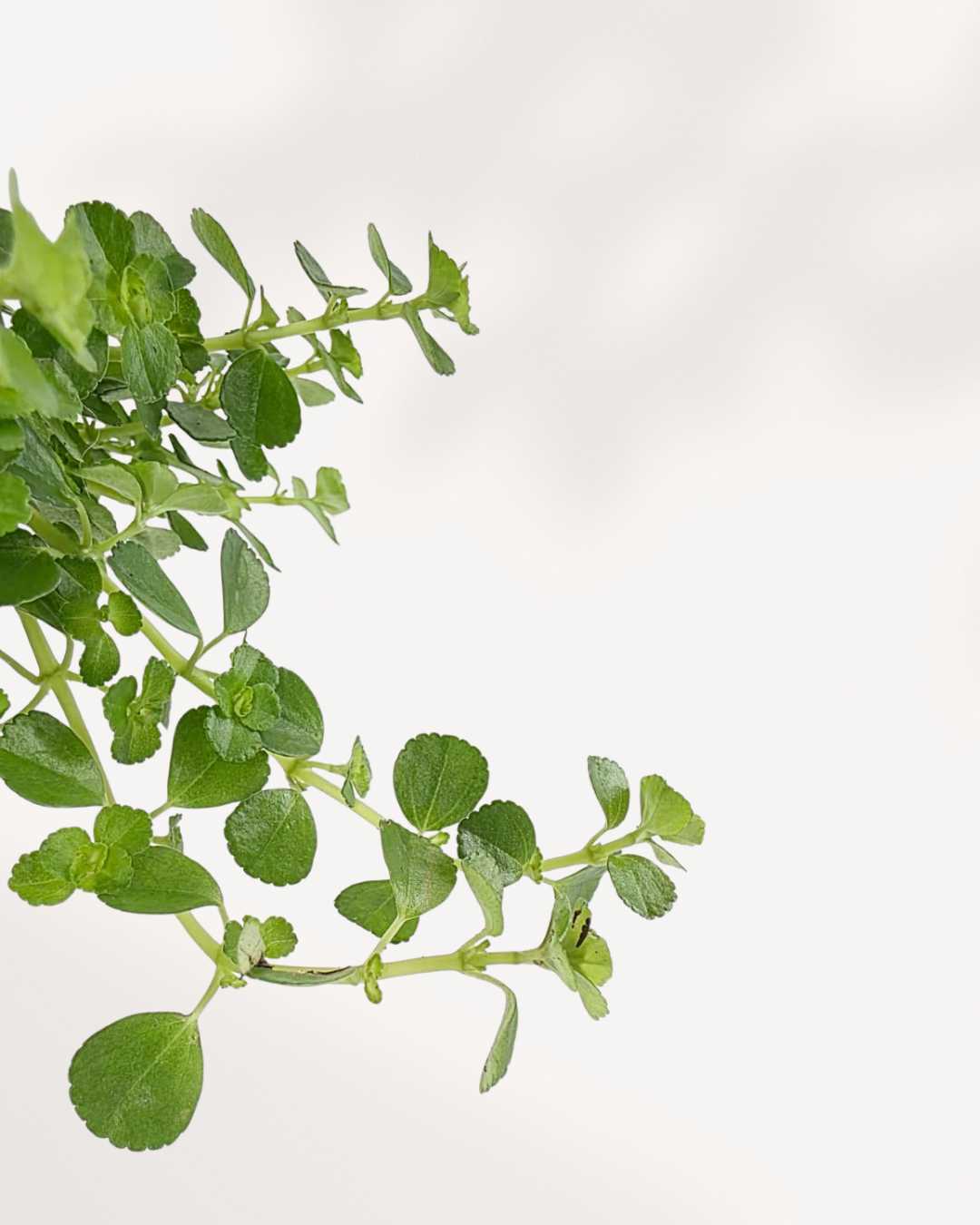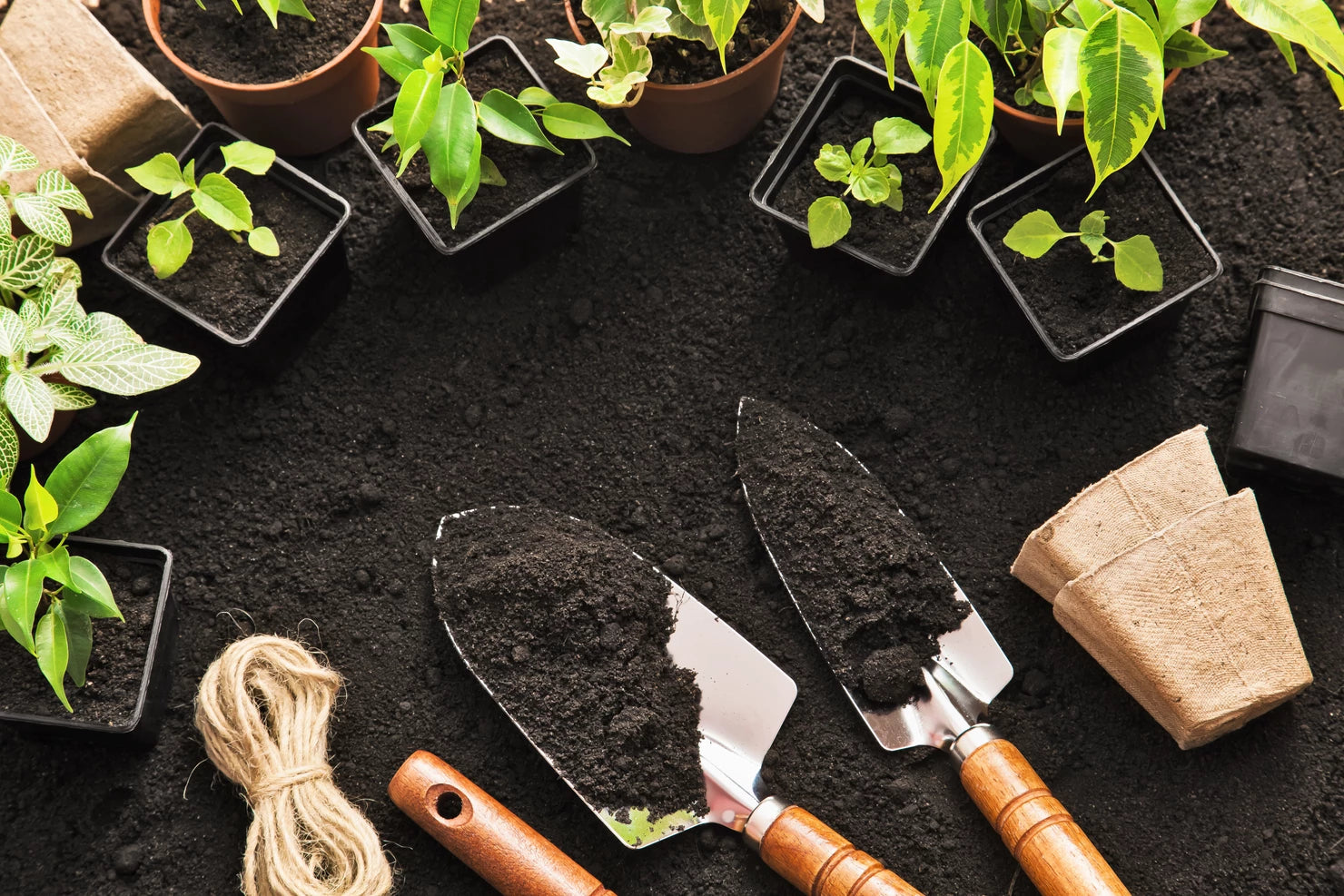Couldn't load pickup availability
Pilea Depressa – Baby Tears Plant with a Cascading Charm
The Pilea Depressa, commonly known as Baby Tears, is a fast-growing trailing plant with clusters of tiny, rounded green leaves. Its soft, cascading growth habit makes it a favorite for hanging baskets, terrariums, or as a lush tabletop accent. Easy to care for and visually delightful, it brings a gentle, refreshing touch to your indoor garden.
Why You'll Love Pilea Depressa
- 🌱 Dense clusters of miniature leaves for a soft, textured look
- 🪴 Perfect trailing plant for shelves, hanging baskets, or terrariums
- ☀️ Thrives in bright, indirect light but tolerates partial shade
- 🐾 Pet-friendly and safe for cats and dogs
Common Names
- Pilea Depressa
- Baby Tears Plant
- Creeping Charlie (not to be confused with invasive ground cover)
Botanical Classification
- Kingdom: Plantae
- Family: Urticaceae
- Genus: Pilea
- Species: Pilea depressa
Where It Comes From
Native to the tropical regions of Central and South America, Pilea Depressa thrives in warm, humid environments. Its natural creeping and trailing growth makes it well-suited for hanging and spreading across surfaces indoors.
A Natural Green Cascade
Pilea Depressa creates a soft, cascading effect with its trailing vines, making it an ideal choice for hanging planters, terrariums, or mixed plant displays. Its vibrant green foliage brings a lively yet calming touch to any room.
What Does It Look Like?
Appearance
Pilea Depressa has tiny, round green leaves with a glossy finish, closely packed along trailing stems. Its dense foliage creates a cushion-like appearance, adding charm and freshness to its surroundings.
Growth Habit
This plant grows quickly and trails gracefully, making it perfect for hanging baskets or as a lush ground cover in larger planters. With the right care, it develops thick cascades of greenery.
Popular Pilea Varieties
Pilea Peperomioides (Chinese Money Plant)
- Known for its round, coin-shaped leaves symbolizing prosperity.
Pilea Cadierei (Aluminum Plant)
- Features striking silver markings on green leaves.
Pilea Involucrata (Friendship Plant)
- Compact plant with bronze-green, textured leaves.
Pilea Moon Valley
- Bright green, deeply veined leaves that thrive in indirect light.
Pilea Glauca (Silver Sparkle Plant)
- Trailing plant with tiny, shimmering silver-green leaves.
Dealing with Pests
Spider Mites
Increase humidity and wipe leaves regularly to prevent infestations. Neem oil or insecticidal soap works well if needed.
Mealybugs
Remove with a cotton swab dipped in alcohol or treat with neem oil spray to keep them away.
Fungus Gnats
Avoid overwatering and let the soil dry slightly between waterings to prevent breeding conditions.
Frequently Asked Questions
How much light does Pilea Depressa need?
It prefers bright, indirect light but can tolerate partial shade. Avoid direct sun which may scorch its leaves.
How often should I water?
Keep the soil consistently moist but not soggy. Allow the top layer to dry slightly before watering again.
Is it safe for pets?
Yes, Pilea Depressa is non-toxic to cats and dogs, making it a safe choice for pet-friendly households.
Can it be grown in terrariums?
Absolutely. Its compact growth and love for humidity make it an excellent terrarium plant.
Bring a Touch of Green Softness to Your Home
Order your Pilea Depressa Baby Tears today and enjoy its lush, cascading foliage that brightens any space.
Shop NowHow to take care of Pilea Glauca
Sun: Indirect
Sun: Indirect
Light: Medium – Bright
Light: Medium – Bright
Water: When Mostly Dry
Water: When Mostly Dry
Humidity: Any
Humidity: Any
Pet Friendly: Yes
Pet Friendly: Yes
Pro Tip
Pro Tip
Delivery Policy for Plant Condition
Delivery Policy for Plant Condition
"I have only received part of my order. What to do?
No worries if you've only got part of your order! Our plants come from different nurseries and might arrive in separate shipments, typically 1-2 days apart. It's all part of ensuring your green friends reach you in top-notch condition!
If you do not receive the remaining packages within 48 hours contact support at info@mygreenscape.ca
What is the Life Time Support?
Absolutely! Lifetime support means you can count on us whenever you have questions or uncertainties about your plant. Whether you're puzzled by its behavior or just want to ensure it's thriving, we're here for you. Connect with us on Instagram @mygreenscapeto or shoot us an email at support@mygreenscape.ca.
When it comes to our guarantee for plants shipped with standard or express, rest assured that we offer a 30-day happy healthy plant guarantee on all such shipments. This ensures that your plants are covered for 30 days after delivery, giving you peace of mind regarding their condition. If you have any concerns within this period, feel free to reach out to us for assistance.
For further details, please visit our Local Delivery, Store Pickup, Standard Shipping Guide Page.
What to expect
What to expect
Your plant will arrive in a standard nursery pot, typically 0.5" - 1" smaller than the stated size to seamlessly fit into your chosen decorative pot. Washable Paper Planter Bags are available for separate purchase.
Just like nature intended, each plant is unique, showcasing natural variations in size, shape, and characteristics. Our commitment is to deliver a plant that closely resembles the one featured on our website, matching your chosen size, and with the potential to thrive happily in your home.
Frequently Asked Questions
Frequently Asked Questions
Certainly! If you're pondering about ordering plants online, you're not alone. We've compiled the most frequently asked questions. Check out our FAQ section here for quick answers! Happy planting!
Plant & Pot Size Chart
Plant & Pot Size Chart
Choosing the right pot size for your plants can be a daunting task, especially if you're new to gardening. But fear not! Our pot sizes chart can help you find the perfect match for your plants, ensuring they have enough space to grow and thrive. With our guide, you'll be able to confidently choose the right pot size and plant variety for your gardening needs.
Plant Pot Size Guide.

| Extra Small | 7-10 cm | 2.5 - 3 inches |
| Small | 11-12 cm | 3.5 - 4 inches |
| Medium | 14-17 cm | 5 - 6 inches |
| Large | 19-21 cm | 8 - 10 inches |
| Extra Large | 24-27 cm | 12 - 14 inches |
All sizes are specified in product details.
Your Complete Guide to Pot Sizes: What Size Should You Choose?

When selecting a pot for your plant, it's important to find the right size. But with all the different options out there, how do you know which one is best? We're here to help!
MyGreenscape's pot sizes chart is a great resource for finding your perfect fit. Our easy-to-read chart takes out all the guesswork and helps you quickly choose the right size for your plant.
Smaller pots are best for seedlings or small plants just starting out. These tend to be shallow but wide, allowing enough room for the roots of the young plant but not too much where they get overcrowded. Medium-sized pots are ideal when your plant has grown from its infancy and is ready for more space. These are deeper and wider than small pots, so that it can accommodate larger root systems - making sure your plant gets enough nourishment while still giving it breathing room. Large pots are top choice if you have an established plant in need of lots of space - think trees and large shrubs! The spacious depth and width allow plenty of room for deep root systems without struggling for air or light.
No matter what size you choose, MyGreenscape has got you covered, with our pot sizes chart guaranteeing you find the perfect fit every time!
Winter Shipping Protection
Winter Shipping Protection
We take extra care with each package during the colder months. For destinations experiencing cold weather, we provide insulated packaging and heat packs as needed to protect your plants from freezing temperatures. With Winter Shipping Protection, your plants are equipped to arrive safe and sound, even in winter’s chill.
Care Guide
Care Guide
Explore essential care tips. check out our Comprehensive Resource for Indoor Plant Care.





WATERING MADE EASY
Check soil moisture before watering and use a potting mix that drains well. It’s the secret to healthy, happy plants!
Hear From Happy Plant Parents.
Who have brought Mygreenscape plants into their homes.




















